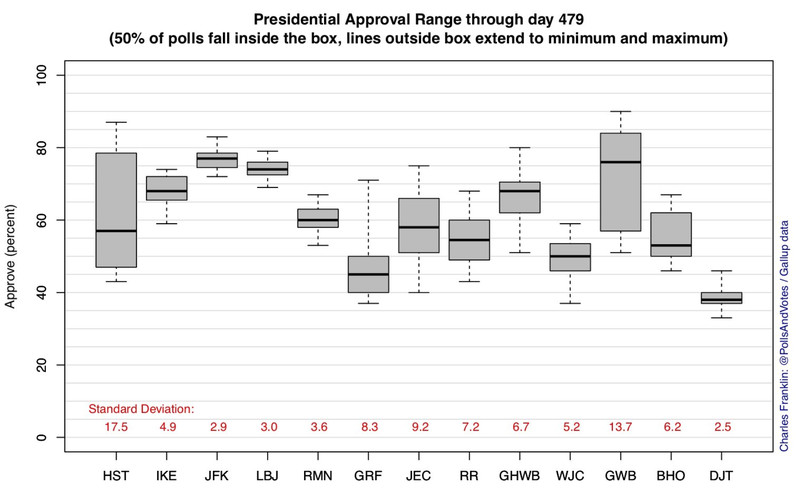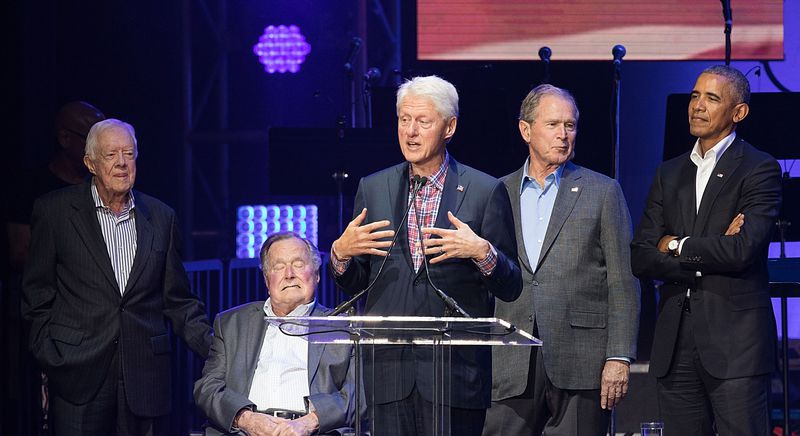
He’s playing a strong hand, poorly.
On June 25, Axios’s Mike Allen and Jim VandeHei took readers inside Donald Trump’s “winning, cynical plan.” They argued that “the more President Trump does, says and tweets outrageous things, the more his critics go bananas and the better he does in the polls.”
The evidence for this was that Trump had hit 45 percent in Gallup’s presidential approval tracker — a personal high for him, though he’s since slipped back to 42 percent. More impressively, Trump’s approval among Republicans is hovering around 90 percent, and special counsel Robert Mueller’s disapproval among Republicans was up to 53 percent.
“It’s arguably the most cynical strategy imaginable,” write Allen and VandeHei. “But that doesn’t mean it can’t be successful politically.”
I should say at the outset: I believe Allen and VandeHei have this one wrong. I don’t think Trump’s poll numbers show he’s found a successful political strategy — quite the opposite, in fact. But this is a difficult debate to have because it requires defining what success would look like for Trump, which means settling on some counterfactual sense of where Trump’s poll numbers could and should be.
Sure, 45 percent, or his current 42 percent, is higher than Trump’s April low of 38 percent, or his all-time Gallup low, last seen in December, of 35 percent. But his numbers have held within a very narrow range since his inauguration. Indeed, Trump’s approval has actually been the most stable of any president in polling history, as this chart from Charles Franklin shows:
 Charles Franklin/Gallup data
Charles Franklin/Gallup dataThe real question, then, is whether the narrow range Trump has settled into represents success or failure. And so we need to establish a baseline: Are Trump’s poll numbers high given what we might expect, or low?
3.8 percent unemployment and 42 percent approval. Is that “winning”?
Here’s another way to think about this question: Would President Marco Rubio or Hillary Clinton or Bernie Sanders or Mitt Romney be at 42 percent amidst 3.8 percent unemployment? I doubt it. But I also can’t prove it.
The strongest argument Allen and VandeHei make, in my view, is that Trump, for all his erratic behavior, is registering numbers in line with some past presidents. They note that at this point, Barack Obama was at 46 percent, Bill Clinton was at 46 percent, Ronald Reagan was at 45 percent, and Jimmy Carter was at 43 percent. This makes Trump’s performance sound, if not impressive, at least normal.
 Rick Kern/Getty Images for Ford Motor Company
Rick Kern/Getty Images for Ford Motor CompanyWhat they fail to note is that all those presidents were managing much more troubled economies than Trump. In June of their second year, the unemployment rate was at 9.4 percent for Obama, 6.1 percent for Clinton, 9.6 percent for Reagan, and 5.8 percent for Carter. (And this understates how bad the economy was, given stagflation and the other aftereffects of the OPEC oil embargo.)
And Allen and VandeHei leave out both George H.W. Bush and George W. Bush. While there were foreign policy dynamics present in their presidencies that make them a tricky fit, I’m not sure they’re worse comparisons than Trump’s combination of peace abroad and extremely low unemployment and high stock prices at home.
According to Gallup, they were at 63 percent and 76 percent approval, respectively, at this point. (It must gall Trump that both Presidents Bush, given how little regard he has for their political skill, were so much more popular at this point in their terms than he is.)
Another way to think about this question is to look at the last time the economy was at 3.8 percent unemployment amid a record stock market. That was in April of 2000, when Bill Clinton registered a 59 percent Gallup approval rating — 17 points above where Trump is now.
I wouldn’t argue that’s a perfect comparison by any means — Clinton’s 3.8 percent unemployment was built atop an objectively stronger economy than Trump’s; wage growth was faster, and we weren’t digging out of the aftermath of a recession — but surely it’s a closer comparison than the sky-high unemployment rates that Reagan and Obama dealt with in their second years.
If unemployment seems like too narrow an indicator of economic health, look at consumer sentiment. The last time consumer sentiment was this high was January 2004, when Bush’s approval rating was 60 percent.
“Trump’s poll numbers are probably 20 points below where a president would typically be with consumer sentiment as high as it is now,” says John Sides, a political scientist at George Washington University who has done work benchmarking presidential approval to economic indicators.
So here, then, is what we can say: Judged on the economy, which is the traditional driver of presidential approval, Donald Trump’s poll numbers should be much, much higher than they are now. Far from finding a winning strategy, he seems to have found a losing one despite holding a winning hand.
The soft bigotry of our low expectations for Donald Trump
That said, I think Allen and VandeHei are reflecting on and responding to a more pervasive sentiment within the Washington political class, and one that I share: Given how Trump is behaving, shouldn’t his numbers be lower?
Trump is being investigated for collusion with Russia and obstruction of justice; he’s responsible for caging children at the border and undermining America’s foreign alliances; his White House is in disarray and he enrages half the country every time he fires up his Twitter feed; he reimbursed his personal lawyer for six figures in hush money to a porn actress, and that lawyer now might be cooperating with investigators.
To those of us who follow politics closely, who feel the chaos Trump has brought to his office acutely, even a 42 percent approval rating seems ridiculously generous.
 Tara Ziemba/Getty Images
Tara Ziemba/Getty ImagesSo let’s reverse the question. Instead of asking why Trump is polling so high, perhaps we should ask why Trump isn’t polling yet lower.
Over email, Republican pollster Kristen Soltis Anderson suggested that polarization is part of the answer. Both Democrats and Republicans had their minds made up about Trump since day one, and that’s left him neither much room to rise nor much room to fall:
Unlike most other presidents in recent decades, Trump’s job approval didn’t have much of anywhere to go because from day one, only 8% of Democrats approve of him. (Past presidents have typically enjoyed job approval in at least the 30s from the opposing party.)
Democrats would not gravitate to Trump under nearly any economic circumstances, but the good economy has insulated him from losing support among Republicans. Even if they don’t like the tweets, they love the jobs numbers, and they love that he seems to be taking on people, groups, and institutions they don’t like. The enemy of my enemy is my friend.
It’s worth saying that this is nothing new for Trump. The 2016 election reflected a similar pattern, where for all of Trump’s unusual behavior, bizarre statements, and ideological challenges, he ended up consolidating roughly the same share of the GOP vote as Mitt Romney and George W. Bush did before him. The fact that he’s managed to continue consolidating Republican support once in office shouldn’t be such a surprise, and nor should the fact that he’s continued to unify Democratic opposition.
Now, I don’t think polarization means a president can’t poll higher than the mid-40s; Obama also governed amidst sharp polarization, and his approval rating was well north of 50 percent in his final year in office. But polarization, along with social media echo chambers, probably puts a floor on both how high a modern president can go and how far one can fall.
The other dynamic here is that Trump’s Twitter feed is a lot more salient to political obsessives than to most Americans. It’s always worth remembering: If you sought out an article on Trump’s poll numbers and made it 1,200 words in — and if you’re here, you did and you have — you’re very weird.
Most people don’t do that. They follow politics episodically and casually, if at all. And so, far from being deeply engaged by the cycle of outrage-and-response that Trump triggers, they ignore most of it and make their judgments based on vaguer, more occasional impressions of political news filtered through a sense of the world around them.
This is another reason I’m skeptical of Allen and VandeHei’s interpretation of the link between Trump’s poll numbers and his tweets and actions. It assumes that too much of the public is glued to the Trump show, when for all Trump’s magnetism, even now, that’s not true. Much of the country, particularly at this point in Trump’s presidency, is tuning the daily drama in Washington out.
So where should Trump be polling? I honestly don’t know. Given how much politics has changed in recent decades — how much we’ve polarized, how fundamentally technology has upended communication, how deeply disillusioned Americans have become with political institutions — I can’t say with confidence where a generic president would be today. But I’m reasonably certain, given the health of the economy, that it’d be above 42 percent, and a president who had truly found a winning rhetorical and governing approach would be well above 50 percent.
One of Trump’s great political talents, if it can be called that, is to behave so bizarrely that the bar is set lower for him than for any president in history. Then he can claim to have defied the doubters when he barely clears the standard he lowered for himself. If another president were polling at 42 percent amid 3.8 percent unemployment, no one in Washington would even consider covering that as a political achievement.
Trump has not managed to become a popular president. In fact, he seems to be squandering an unusually strong run of peace and prosperity. If Trump and his advisers are fooling themselves into believing otherwise, that’s a more interesting fact about the administration’s internal echo chamber than it is a convincing analysis of reality.
Read More
https://cdn.vox-cdn.com/community_logos/52517/voxv.png


